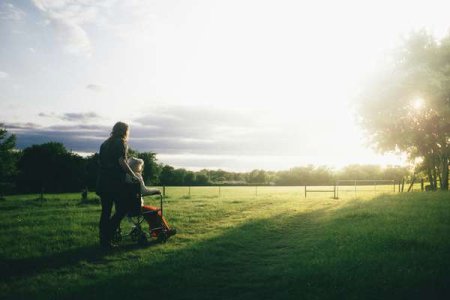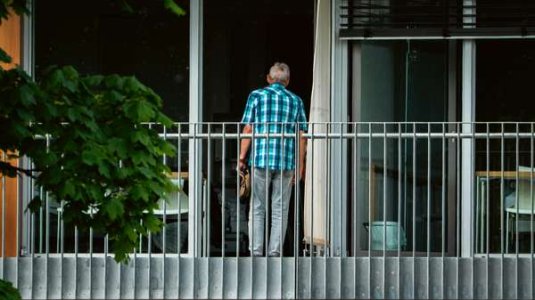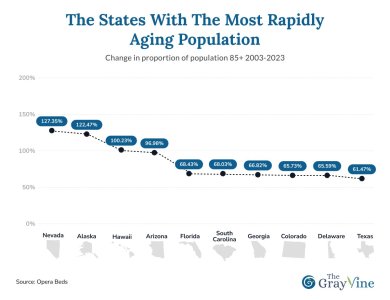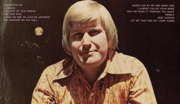Elder care in danger: Nursing homes shutter as demand soars
- Replies 1
If you or someone you love is over 60, you’ve probably noticed the headlines: America is getting older, and fast.
But here’s a twist that’s raising eyebrows and blood pressure alike—just as our population of seniors is booming, the number of nursing homes is quietly shrinking. It’s a trend that’s leaving families, caregivers, and policymakers scrambling for answers—and solutions.
Let’s dig into what’s really happening, why it matters, and what it could mean for you and your loved ones.
A Growing Silver Wave, But Fewer Places to Land
Between 2015 and 2024, more than 820 nursing facilities closed their doors across the United States.
According to data from Opera Beds, a company that tracks healthcare infrastructure, 45 out of 51 states saw a drop in nursing homes—even as the number of Americans aged 85 and older soared by 39% between 2003 and 2023.
To put it in perspective: Nevada’s 85+ population grew by a staggering 127% from 2003 to 2023.
Alaska and Hawaii weren’t far behind, with increases of 122% and 100%, respectively. Yet, these same states are now facing a shortage of care facilities, and the problem is only expected to get worse.

The trend risks placing added pressure on the nursing homes and homecare providers that remain nationwide.
States with rapidly aging populations—like Alaska—may soon be required to significantly boost their spending on elderly healthcare services.
The aging demographic in the US, paired with a declining birth rate, also presents major economic hurdles.
Among them are a shrinking workforce, reduced tax income, and a growing number of people depending on publicly funded programs such as Social Security.
This might help: How at-risk is your area? New 2025 data highlights earthquake vulnerability across the US
Why Are Nursing Homes Disappearing?
There’s no single reason for the decline. According to Opera Beds, between 2015 and 2024, Montana experienced the most significant drop in nursing facilities, with a 28 percent decrease.
Maine followed with a 21 percent decline, and Massachusetts saw a 17 percent reduction.
The report identified Arizona as the state least equipped to support its aging population, with only 142 nursing facilities—translating to 1,050 individuals aged 85 and older for each facility. Hawaii followed closely with 958 seniors per facility, and Florida with 836.
On the other end of the spectrum, Iowa was found to be the most prepared, offering 412 nursing facilities—equivalent to one for every 174 residents over age 85.
Also read: Is Trump's immigration crackdown forcing American elderly into crisis? Find out how
"The state's strong infrastructure for elderly care may be attributed to its rural composition and policies emphasizing accessible healthcare services for older residents," the report noted.
"Additionally, Iowa's long-standing commitment to senior care ensures its ageing population has more options for assisted living and skilled nursing care than in many other states."
The analysis was based on data from the US Census Bureau and health policy research group KFF.
The Bigger Picture: America’s Aging Dilemma
In its report, Opera Beds stated: "The United States is experiencing a significant demographic shift as its population ages rapidly, with projections indicating a substantial increase in the number of older adults in the coming decades. As the proportion of individuals aged 60 and above grows, the strain on healthcare and homecare services... is becoming more apparent."

James Pomeroy, a global economist at HSBC, previously told Newsweek that the aging population in the US, coupled with declining birth rates, poses a “massive problem.”
"In the US, the number of over-65s is expected to rise by more than 1.5 percent per year every year for the next decade," he said. "That means that when birth rates are so low, population pyramids becoming inverted very quickly. Less migration takes people out of the middle section of that pyramid, too, so you would expect the share of the US population of pensionable age to rise quickly in the coming years as a result, which brings big social and economic change."
What’s Next?
Opera Beds forecasts a sharp rise in the US population aged 85 and older by 2043. In Alaska specifically, that age group could more than double, reaching two percent of the state’s total population.
Read next: A caregiving crisis is growing across the US—here’s what families need to know now

Have you or your family faced challenges finding quality care? Are you worried about what the future holds for senior living in your state? Or maybe you’ve found creative solutions that others could learn from? Share your stories, questions, and ideas in the comments below!
But here’s a twist that’s raising eyebrows and blood pressure alike—just as our population of seniors is booming, the number of nursing homes is quietly shrinking. It’s a trend that’s leaving families, caregivers, and policymakers scrambling for answers—and solutions.
Let’s dig into what’s really happening, why it matters, and what it could mean for you and your loved ones.
A Growing Silver Wave, But Fewer Places to Land
Between 2015 and 2024, more than 820 nursing facilities closed their doors across the United States.
According to data from Opera Beds, a company that tracks healthcare infrastructure, 45 out of 51 states saw a drop in nursing homes—even as the number of Americans aged 85 and older soared by 39% between 2003 and 2023.
To put it in perspective: Nevada’s 85+ population grew by a staggering 127% from 2003 to 2023.
Alaska and Hawaii weren’t far behind, with increases of 122% and 100%, respectively. Yet, these same states are now facing a shortage of care facilities, and the problem is only expected to get worse.

The number of nursing facilities in the United States has dropped sharply between 2015 and 2024, despite the country’s rapidly growing aging population. Image source: Dominik Lange / Unsplash.
The trend risks placing added pressure on the nursing homes and homecare providers that remain nationwide.
States with rapidly aging populations—like Alaska—may soon be required to significantly boost their spending on elderly healthcare services.
The aging demographic in the US, paired with a declining birth rate, also presents major economic hurdles.
Among them are a shrinking workforce, reduced tax income, and a growing number of people depending on publicly funded programs such as Social Security.
This might help: How at-risk is your area? New 2025 data highlights earthquake vulnerability across the US
Why Are Nursing Homes Disappearing?
There’s no single reason for the decline. According to Opera Beds, between 2015 and 2024, Montana experienced the most significant drop in nursing facilities, with a 28 percent decrease.
Maine followed with a 21 percent decline, and Massachusetts saw a 17 percent reduction.
The report identified Arizona as the state least equipped to support its aging population, with only 142 nursing facilities—translating to 1,050 individuals aged 85 and older for each facility. Hawaii followed closely with 958 seniors per facility, and Florida with 836.
On the other end of the spectrum, Iowa was found to be the most prepared, offering 412 nursing facilities—equivalent to one for every 174 residents over age 85.
Also read: Is Trump's immigration crackdown forcing American elderly into crisis? Find out how
"The state's strong infrastructure for elderly care may be attributed to its rural composition and policies emphasizing accessible healthcare services for older residents," the report noted.
"Additionally, Iowa's long-standing commitment to senior care ensures its ageing population has more options for assisted living and skilled nursing care than in many other states."
The analysis was based on data from the US Census Bureau and health policy research group KFF.
The Bigger Picture: America’s Aging Dilemma
In its report, Opera Beds stated: "The United States is experiencing a significant demographic shift as its population ages rapidly, with projections indicating a substantial increase in the number of older adults in the coming decades. As the proportion of individuals aged 60 and above grows, the strain on healthcare and homecare services... is becoming more apparent."

Some states—such as Nevada, Alaska, and Hawaii—have seen their population aged 85+ more than double in recent decades, further straining existing elderly care resources. Image source: Patrick von der Wehd / Unsplash.
James Pomeroy, a global economist at HSBC, previously told Newsweek that the aging population in the US, coupled with declining birth rates, poses a “massive problem.”
"In the US, the number of over-65s is expected to rise by more than 1.5 percent per year every year for the next decade," he said. "That means that when birth rates are so low, population pyramids becoming inverted very quickly. Less migration takes people out of the middle section of that pyramid, too, so you would expect the share of the US population of pensionable age to rise quickly in the coming years as a result, which brings big social and economic change."
What’s Next?
Opera Beds forecasts a sharp rise in the US population aged 85 and older by 2043. In Alaska specifically, that age group could more than double, reaching two percent of the state’s total population.
Read next: A caregiving crisis is growing across the US—here’s what families need to know now
Key Takeaways
- The number of nursing facilities in the United States has dropped sharply between 2015 and 2024, despite the country’s rapidly growing aging population.
- Some states—such as Nevada, Alaska, and Hawaii—have seen their population aged 85+ more than double in recent decades, further straining existing elderly care resources.
- States like Arizona, Hawaii, and Florida are among the least prepared for elderly care, with very few nursing facilities available per older resident, while Iowa is the best prepared.
- Experts warn the decline in nursing facilities, combined with an ageing population and low birth rates, is likely to create significant social and economic challenges for the U.S. in coming years.
Have you or your family faced challenges finding quality care? Are you worried about what the future holds for senior living in your state? Or maybe you’ve found creative solutions that others could learn from? Share your stories, questions, and ideas in the comments below!







